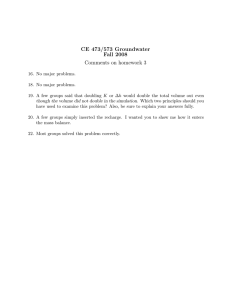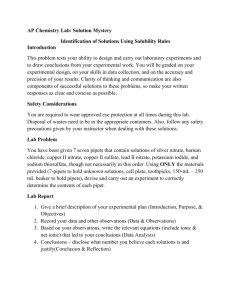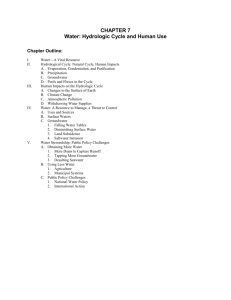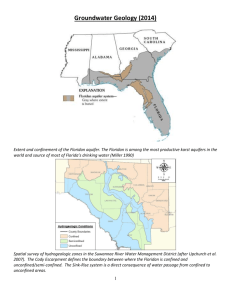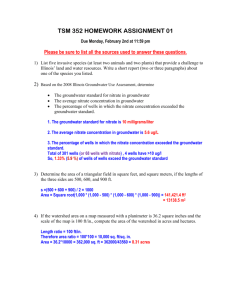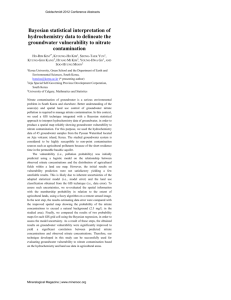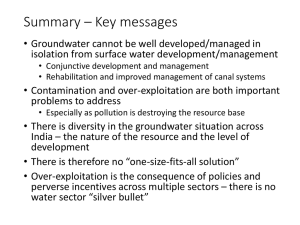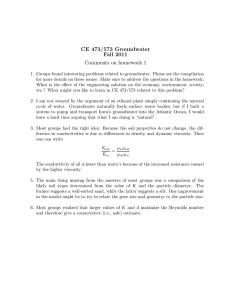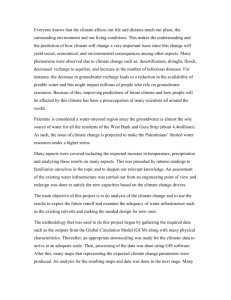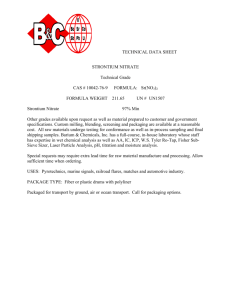Wellhead Protection Plan and Remediation
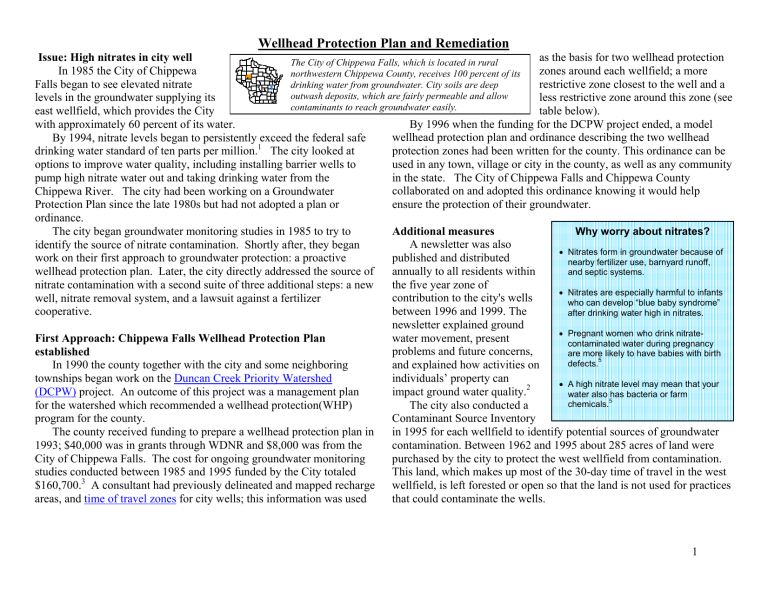
Issue: High nitrates in city well
In 1985 the City of Chippewa
Falls began to see elevated nitrate levels in the groundwater supplying its east wellfield, which provides the City with approximately 60 percent of its water.
Wellhead Protection Plan and Remediation
The City of Chippewa Falls, which is located in rural northwestern Chippewa County, receives 100 percent of its drinking water from groundwater. City soils are deep outwash deposits, which are fairly permeable and allow contaminants to reach groundwater easily. as the basis for two wellhead protection zones around each wellfield; a more restrictive zone closest to the well and a less restrictive zone around this zone (see table below).
By 1996 when the funding for the DCPW project ended, a model
By 1994, nitrate levels began to persistently exceed the federal safe drinking water standard of ten parts per million.
1
The city looked at options to improve water quality, including installing barrier wells to wellhead protection plan and ordinance describing the two wellhead protection zones had been written for the county. This ordinance can be used in any town, village or city in the county, as well as any community pump high nitrate water out and taking drinking water from the
Chippewa River. The city had been working on a Groundwater
Protection Plan since the late 1980s but had not adopted a plan or ordinance.
The city began groundwater monitoring studies in 1985 to try to identify the source of nitrate contamination. Shortly after, they began work on their first approach to groundwater protection: a proactive wellhead protection plan. Later, the city directly addressed the source of nitrate contamination with a second suite of three additional steps: a new well, nitrate removal system, and a lawsuit against a fertilizer cooperative.
First Approach: Chippewa Falls Wellhead Protection Plan established
In 1990 the county together with the city and some neighboring townships began work on the Duncan Creek Priority Watershed
(DCPW) project. An outcome of this project was a management plan for the watershed which recommended a wellhead protection(WHP) program for the county.
The county received funding to prepare a wellhead protection plan in
1993; $40,000 was in grants through WDNR and $8,000 was from the
City of Chippewa Falls. The cost for ongoing groundwater monitoring studies conducted between 1985 and 1995 funded by the City totaled
$160,700.
3
A consultant had previously delineated and mapped recharge areas, and time of travel zones for city wells; this information was used in the state. The City of Chippewa Falls and Chippewa County collaborated on and adopted this ordinance knowing it would help ensure the protection of their groundwater.
Additional measures
A newsletter was also published and distributed annually to all residents within the five year zone of contribution to the city's wells between 1996 and 1999. The newsletter explained ground water movement, present problems and future concerns, and explained how activities on individuals’ property can impact ground water quality.
2
Why worry about nitrates?
•
Nitrates form in groundwater because of nearby fertilizer use, barnyard runoff, and septic systems.
•
Nitrates are especially harmful to infants who can develop “blue baby syndrome” after drinking water high in nitrates.
•
Pregnant women who drink nitratecontaminated water during pregnancy are more likely to have babies with birth defects.
5
•
A high nitrate level may mean that your water also has bacteria or farm chemicals.
5
The city also conducted a
Contaminant Source Inventory in 1995 for each wellfield to identify potential sources of groundwater contamination. Between 1962 and 1995 about 285 acres of land were purchased by the city to protect the west wellfield from contamination.
This land, which makes up most of the 30-day time of travel in the west wellfield, is left forested or open so that the land is not used for practices that could contaminate the wells.
1
Reflections on Wellhead Protection Program
Weaknesses
The WHP ordinance does not address pre-existing land uses that are still contaminating the groundwater in the recharge area. One of county worked together to protect groundwater. Because some of the recharge area of the municipal wells is not in the city limits, that area is still protected under the county ordinance. In the well recharge area, these uses is a fertilizer plant (see below). Even today, some practices of the existing industries are not sound engineering. These land uses would not have been allowed if the wellhead protection ordinance had been in effect before these industries were located in the recharge area.
There are some farms operating in the five to ten year time of land uses are now regulated to prevent potentially damaging practices from contaminating drinking water. Some land uses are prohibited.
When a conditional use is allowed, the operation must follow Best
Management Practices.
As of 1996, all municipal wells in Wisconsin are required to have travel area that are unregulated by the ordinance and their cropping practices have the potential to contaminate groundwater. Monitoring wells and private wells in the area have shown there is high nitrate in
Wellhead Protection Plans including delineation of well recharge areas. Chippewa
Definition: “Time of travel”zone
(Also known as “zone of concentration” or “zone of the five to ten year time of travel zone from the wellfields. Falls’ WHP plan exceeds this contribution”) requirement in two ways: it The wellhead protection ordinance does not address quantity of
A specific area of land, where water water. This could leave the recharge area open to uses that consume
By 2001 the city met safe drinking water standards and nitrate was near 6.7 parts per million after treatment and blending.
3
The city and has an ordinance to help than a fixed radius around the well, which is less accurate. soaking into the ground reaches the well large quantities of water that may result in drawdown of the aquifer.
implement its plan, and the after a specific period of time. For example, a drop of water entering the recharge areas are based on ground in an area defined as a five year
Strengths time travel to the well, rather time of travel would take five years to reach the well.
Zone one
Zone two
Time of
Travel
30 day time of travel
5 year time of travel
Chippewa Falls and Chippewa County Wellhead Protection District
Permitted Uses
Conditional
Uses
9 Parks, playgrounds, beaches, with no on-site wastewater disposal systems or holding tanks;
9 Wildlife and woodland areas
9
Biking, hunting, skiing, nature equestrian and fitness trails
9 Municipally sewered residential development
9 Agricultural crop production with nutrient management
9 All uses in zone one
9
Parks, playgrounds, beaches with onsite wastewater discharged to a holding tank or municipal sewer
9
Single family residences on minimum lot size with less than 8,000 gallons per day of sewage
9 Residential use of above ground LP gas tanks less than 1,000 gallons for heating
9 Municipally sewered commercial and industrial establishments with less than 20 gallons or
160 pounds of regulated substances in use, storage or production at a time
May request a permit for any use not explicitly prohibited
Prohibited Uses
Applies to Zones one and two:
Buried hydrocarbon, petroleum or hazardous chemical storage tanks, cemeteries, chemical manufacturers, coal storage, dry cleaners, industrial lagoons and pits, etc.
2
Second approach: New well & nitrate removal system and lawsuit
In 1995, the city needed to add another well, which cost $115,000 to install. Nitrate levels were lowest in well number five. The city could have used water from well five to blend with other water to get the overall nitrate level below the federal safe drinking water level.
However as nitrate levels began trending up, blending would only have been a stopgap measure.
In January 1997 the water utility still needed to take an additional step and install a $2.2 million dollar, (costing $170 per person), nitrate removal system in the east well-field after nitrate levels failed to decrease.
1,3
Annual costs for chemicals, labor, and maintenance are about $81,000.
Through testing and collaboration with The Department of
Agriculture Trade and Consumer Protection (DATCP) the city later found that nitrates were coming from a nearby agricultural fertilizer distributor and a possibly from a rendering plant with on-site lagoon.
These industries were located less than 100 meters from the wellfield.
DATCP had been monitoring spills from the fertilizer cooperative for three years before 1999 when the city learned that it was a major source of nitrate in the drinking water. Chippewa Falls filed a lawsuit against the local fertilizer cooperative in 2000 after they refused to admit liability and participate in remediation efforts.
The lawsuit was settled out of court after three years of litigation; continuing with the case would have cost the city too much and was unlikely to recover the entire costs of cleanup, monitoring and new well construction much less result in additional compensation. The city opted for a monetary settlement and continued monitoring of the fertilizer plant by DATCP.
Reflections on Lawsuit and Remediation
Strengths
The fertilizer cooperative was required to pay the city a sum of
$525,000. ‘The City of Chippewa Falls benefited from the settlement in two ways. The settlement award of $525,000 partially reimbursed the city for the cost of the nitrate removal system. In addition, the city succeeded in increasing the attention to the potential for continued nitrate contamination from the cooperative site.’
1
DATCP has also forced the original owners of the fertilizer cooperative to continue pay for ongoing investigation and monitoring at the site, as well as sampling of city wells.
The fertilizer cooperative is now under new ownership and management and required to file reports with DATCP on the amount and type of fertilizer and agricultural chemicals handled and applied.
Weaknesses
The settlement did not include discussion to relocate the fertilizer plant and there have still been spills under the new managers. They are doing more loading and unloading on concrete but dust flies, builds up on the ground and then soaks into the ground. Equipment is parked outdoors where rain falls on it and carries fertilizer and other agricultural chemical residue off it. There are similar concerns with liquid fertilizer because of leaking tanks and disposal of contaminated rainwater from containment areas. This industry has inherent problems for groundwater contamination.
Future
Through the well testing there have been detections of other agricultural chemicals and breakdown products of agricultural chemicals such atrazine, metalochor, acetochlor but not over the MCL.
This is not surprising since the presence of nitrate is often a precursor to other chemicals due to its relatively rapid infiltration into groundwater. City well testing will continue with frequency determined by contaminant levels and trends.
The WHP ordinance will prevent future additional sources of potential groundwater contamination in the wellhead protection area, possibly maintain open space and wildlife habitat, and improve intergovernmental cooperation. Chippewa Falls has not noticed a significant improvement in groundwater quality since the ordinance was enacted, but it often takes decades for soils and groundwater to be cleansed of contaminants.
Portage County in central Wisconsin implemented a similar WHP ordinance before Chippewa County did. Their program has been
3
successful in deterring some groundwater unfriendly businesses from locating in the wellhead protection zones. This is part of why
Chippewa Falls expects to prevent future contamination; new land uses that could contribute will not be allowed in the recharge area.
Chippewa Falls’ experience shows that a WHP ordinance is more effective if implemented before contamination is a problem. However most Wisconsin communities do not have WHP ordinances; hopefully they will implement them before they experience drinking water contamination.
This case study was written by Bobbie Webster and Lynn Markham
For more information:
Rick Rubenzer, Public Works Director, City of Chippewa Falls,
30 West Central Street Chippewa Falls, WI 54729
Phone: (715) 726-2736 e-mail: rrubenzer@ci.chippewa-falls.wi.us
Sources :
1.
Nelson, Jennifer. An Ounce of Prevention. The Aquifer. Vol 18. No. 2. 2003.
< http://www.groundwater.org/gg/activities/ROA_18_2.pdf
> Accessed 2005
March.
2.
Williams M, Fenske B. Demonstrating Benefits for Wellhead Protection
Programs. American Water Works Association Research Foundation Report.
2004.
3.
Wisconsin Department of Natural Resources. Example Wellhead Protection
Ordinances. < http://dnr.wi.gov/org/water/dwg/gw/whp/WHP_ORDA.pdf
>.
Accessed 2005 March.
4.
Wisconsin Department of Natural Resources. 2003 Jan. Nitrate.
< http://www.dnr.state.wi.us/org/water/dwg/nitrate.htm
>. Accessed 2005
March.
5.
Wisconsin Department of Health and Family Services. 2005 Jun. Drinking
Water.
< http://dhfs.wisconsin.gov/hometips/dhp/water.htm
>. Accessed 2005 May.
Timetable of wellhead protection events 1985 - 2005
1985
City of Chippewa Falls begins to see elevated nitrate levels in drinking water
1993
1995
City begins Wellhead
Protection Plan
City adds new well
1996
1997
2000
2001
Wellhead protection plan and ordinance adopted
City builds nitrate removal system
City sues fertilizer cooperative
Nitrate levels decrease
2003
2005
City and fertilizer co-op reach settlement
City continues groundwater protection efforts
4
